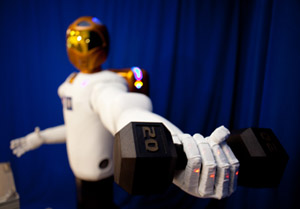NASA has revealed a new generation of astronaut robots that are tough, strong and dextrous enough to go to space to complete complex missions and oh yeah … they can work in car factories when they’re not in space.
NASA and General Motors are working together to accelerate development of the next generation of robots and related technologies for use in the automotive and aerospace industries.
Engineers and scientists from NASA and GM worked together through a Space Act Agreement at the agency’s Johnson Space Center in Houston, Texas, to build a new humanoid robot capable of working side by side with people.
Using leading-edge control, sensor and vision technologies, future robots could assist astronauts during hazardous space missions and help GM build safer cars and plants.
About Robonaut 2
The two organisations, with the help of engineers from Oceaneering Space Systems of Houston, developed and built the next iteration of Robonaut. Robonaut 2, or R2, is a faster, more dexterous and more technologically advanced robot.
This new generation robot can use its hands to do work beyond the scope of prior humanoid machines. R2 can work safely alongside people, a necessity both on Earth and in space.
“This cutting-edge robotics technology holds great promise, not only for NASA, but also for the nation,” said Doug Cooke, associate administrator for the Exploration Systems Mission Directorate at NASA Headquarters in Washington, DC.
“I’m very excited about the new opportunities for human and robotic exploration these versatile robots provide across a wide range of applications.”
The idea of using dexterous, human-like robots capable of using their hands to do intricate work is not new to the aerospace industry.
About the original Robonaut
The original Robonaut, a humanoid robot designed for space travel, was built by the software, robotics and simulation division at Johnson in a collaborative effort with the Defense Advanced Research Project Agency 10 years ago. During the past decade, NASA gained significant expertise in building robotic technologies for space applications. These capabilities will help NASA launch a bold new era of space exploration.
“For GM, this is about safer cars and safer plants,” said Alan Taub, GM’s vice-president for global research and development.
“When it comes to future vehicles, the advancements in controls, sensors and vision technology can be used to develop advanced vehicle safety systems. The partnership’s vision is to explore advanced robots working together in harmony with people, building better, higher quality vehicles in a safer, more competitive manufacturing environment.”
NASA and GM have a long, rich history of partnering on key technologies, starting in the 1960s with the development of the navigation systems for the Apollo missions. GM also played a vital role in the development of the Lunar Rover Vehicle, the first vehicle to be used on the moon.
“Our challenge today is to build machines that can help humans work and explore in space,” said Mike Coats, Johnson’s centre director.
“Working side by side with humans, or going where the risks are too great for people, machines like Robonaut will expand our capability for construction and discovery.”
By John Kennedy

Photo: Robonaut2 surpasses previous dexterous humanoid robots in strength, yet it is safe enough to work side-by-side with humans. It is able to lift, not just hold, this 20-pound weight (about four times heavier than what other dexterous robots can handle) both near and away from its body